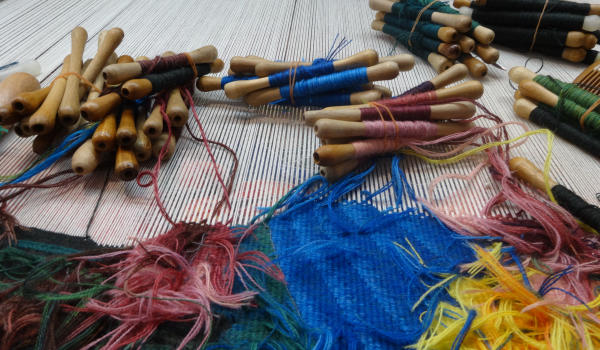
The Cité Internationale de la Tapisseries Aubusson (International Center of Aubusson Tapestry) represents far more than a pat on the back to the history of tapestry-making in the Creuse region. It also reaffirms and encourages the continuity of know-how for the entire branch of tapestry-related activities, from the raising of sheep and the spinning and dying of wool to the creation of images and their weaving into an extraordinary array of contemporary tapestries in Aubusson, Felletin and elsewhere in Creuse.
* * *
Urbanites in France often speak of Creuse, a region deep into the often bypassed center of the country, as the kind of place to which you might flee to escape the rat race and surround yourself with goats and sheep, the proverbial middle of nowhere.
France Revisited takes pleasure in revealing the somewhere of such nowheres, and there is nowhere more somewhere in Creuse than the small town of Aubusson, world famous for its 500 years of tapestry-making.
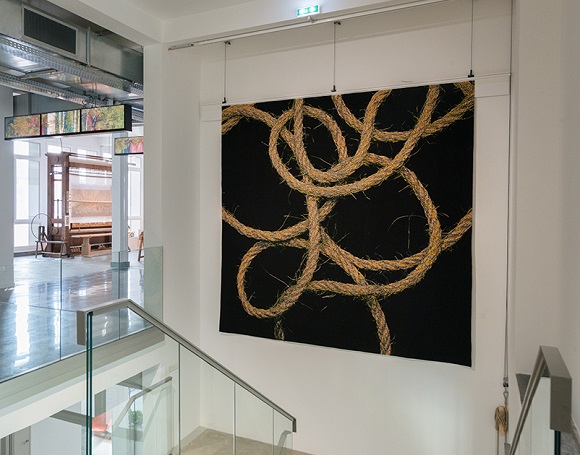
Cité Internationale de la Tapisserie Aubusson
The Cité Internationale de la Tapisserie Aubusson (International Center of Aubusson Tapestry), which opened in July 2016, represents far more than a pat on the back to the history of tapestry-making in the region. It also reaffirms and encourages the continuity of know-how for the entire branch of tapestry-related activities present in Creuse, from the raising of sheep and the spinning and dying of wool to the creation of images and their weaving into an extraordinary array of contemporary tapestries.
The Cité is at once a museum, an institution for the transmission of know-how, a research center, a start-up incubator for related businesses and a platform for the promotion and creation of contemporary tapestries.
Taking the relay from an older, smaller museum, the Cité project was in the works for over 20 years, but truly began to take shape in 2009 when Aubusson tapestry-making gained entry onto UNESCO’s Representative List of the Intangible Cultural Heritage.
As a museum, the Cité displays examples of tapestries since the 15th century, including a dramatic presentation of works through the ages presented in a series of theatrical decors. The techniques of tapestry-making and their use around the world are also presented. And 12 weavers (lissiers in French) are admitted every two years to the Cité’s two-year program for budding weavers. Also, State-owned tapestries are now restored here.
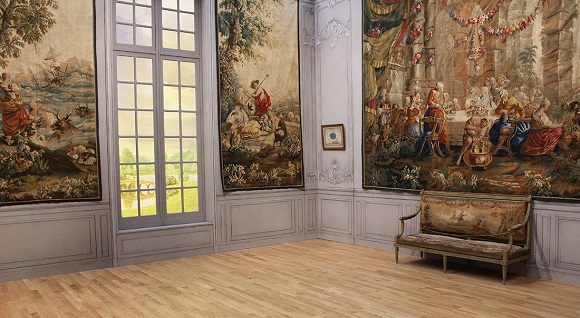
Weavers, les lissiers
Visiting the Cité Internationale de la Tapisserie Aubusson is one of the rewards of a detour into the middle of the somewhere of Creuse. And enhancing that rewards is the possibility to meet individuals who carry and transmit the know-how associated with the creation of Aubusson tapestries.
Since 2010, the Cité has supported the work of regional artisans in the development of contemporary creations. Each year it calls on artists from around the world to present projects according to a given theme. The three selected projects are then woven in Creuse. In order to be considered an Aubusson a tapestry needn’t be woven in the town itself but anywhere within Creuse. The two main centers of creation, however, are Aubusson and Felletin.
France-Odile Perrin-Crinière in Aubusson
In 2015 France-Odile Perrin-Crinière’s workshop-gallery A2, located in the center of Aubusson, received a commission from the Cité to weave a richly colored 3m x 5m (about 9.8ft x 16.4ft) tapestry called “The Family in the Joyful Greenery” based on an image by Argentinian artists Leo Chiachio and Daniel Giannone.
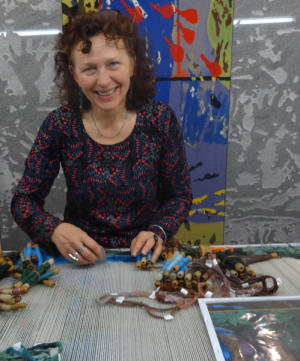
Enter Perrin-Crinière’s workshop-gallery and you’ll see two (or three if she, too, has her hands on the wool) highly-skilled artisans leaning over a long horizontal loom. They work with patience, skill and comradery before a web of yarns, knots and colors—300 nuances in all. They’ve been at it for over 18 months now, and the tapestry is expected to “fall” from the loom in another six month (spring 2017). They weave without even seeing the actual face of the tapestry since a tapestry is woven from its back.
Perrin-Crinière’s route to becoming the master artisan at the helm of a well-established little workshop began in 1978 when, at the age of 16, she left her home in the Landes region of southwest France to learn tapestry-making at Aubusson. After three years of schooled training followed by several years honing her skills working for others, she struck out on her own as a creator-weaver, meaning that in addition to following the designs of others she would weave her own designs. In 2010 she partnered with another weaver to create the workshop A2. The unexpected early retirement of her partner left Perrin-Crinière alone at A2 just as the major commission from the Cité arrived.
In need of employees she turned to the two-year formal training program run by the Cité. She hired two weavers whose entrance into the field was quite different from her own.
Patricia Bergeron, a Creuse native, had a long career assisting the elderly before undertaking a professional reconversion to become a weaver. “Ever since I was little I’ve worked with my fingers,” she says. “I did embroidery and knitting, without thinking that I’d eventually turn to working in a workshop like this.”

Aubusson’s international reputation meant that Aiko Konomi knew of Aubusson tapestries in her native Japan, where she received a master’s degree in contemporary art fabrics. She arrived in 2014 to study in the Cité’s program. For financial reasons and because of her prior experience working towards her master’s degree, she only completed one year of the program before Perrin-Crinière hired her. Bergeron and Konomi now work daily on the commissioned tapestry while Perrin-Crinière puts in time here and there between weaving smaller orders on other looms and running workshops.
A2 has now earned the label Entreprise du Patrimoine Vivant (Living Heritage Company, or EPV), a distinction given by the French State in recognition of excellence in traditional and industrial skills.
While working on this major commission as an artisan at the service of art (artisan d’art), Perrin-Crinière continues to create and execute her own designs in which she marries color and material, such as a tapestry framed by slate (e.g. the work behind her in the photo above).
Catherine Bernet in Felletin

A pretty 10-kilometer (6-mile) drive south through the wooded valley from Aubusson, leads to Felletin, a small town of 1800 inhabitants, less than half the size of Aubusson. If Aubusson is France’s tapestry capital, Felletin is its cradle since tapestry work has been documented here since the middle of the 15th century, even before Aubusson. More than 500 years later, Felletin remains a force in the Aubusson tapestry industry. The tennis-court size tapestry at Coventry Cathedral, designed by the British artist Graham Sutherland and completed in 1962, was made on a single loom in Felletin by Pinton, one of the largest manufacturers in the region.
As Perrin-Crinière passed the half-way mark of her commissioned tapestry at A2, the Cité’s commission to Catherine Bernet and her Atelier Bernet was falling from its loom after two years of weaving. (A tapestry “falls” from the loom when the weaving is complete.) For the first time Bernet could see the full 2m x 8m (6.6ft x 26.2ft) tapestry face up. But no sooner had its fall from the loom been celebrated then the tapestry was turned over again so that she could set to work bunching and cutting the pompoms on the back.
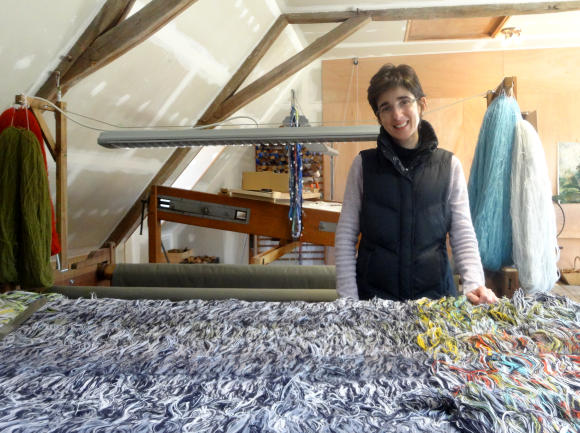
The tapestry is the door-rug intended to be partially hung, partially laid flat (see photo) in the lobby of the Cité Internationale. The image for tapesry, officially title “Toute personne 2 – Tissage métissage,” was created by Vincent Bécheau and Marie-Laure Bourgeois, architect-designers from Dordogne who, Bernet says, “actively participated without hindering the work.”
Both Bernet and Perrin-Criniere speak of the “relation of confidence” between the weaver and the artist-cartoonist. (The image that a tapestry is based on is called a cartoon, carton in French.) “A tapestry is necessarily a collaborative work, a dialogue between the two,” says Bernet.
Bruno Ythier, curator of the Cité, says that while weavers may be creators of the images for the tapestries they create, Aubusson largely represents an encounter between the image’s creator (an artist, a decorator, an architect or another) and the weaver who then interprets that image.
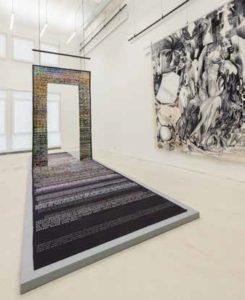
Bernet’s workshop in an attic partially bathed in natural light in a house near the center of Felletin. She works with two employees, one a young weaver whom she employed freshly graduated from the Cité weaving program, the other a weaver with 35 years of experience.
Originally from nearby Auvergne, Bernet came to tapestry-making in 2010, at the age of 34, having begun her professional career as a pharmacist. “In my free time I did a lot of painting and sculpting, but it was impossible to include my artistic side into my professional life,” she says.
She discovered tapestry-making “a little by chance” and, after giving that discovery time to mature in her mind, she crossed the border from Auvergne to Creuse and from pharmacy to craftsmanship.
Instead of seeking to enter Cité’s program, she apprenticed directly within with the Pinton workshop in order to better understand “the reality of the work.” “Having left my previous work, I couldn’t afford to make a mistake,” she says, “so I wanted to go directly to the heart of the matter to see if it was for me or not.”
It was.
In 2013 she set up her own shop. No sooner had she hung out her shingle then she sought and received the commission from the Cité to weave the door-rug which now prominently stands-lies in its lobby.
Asked if he ever misses her work as a pharmacist Bernet says, “There’s great joy [in being a lissière] but it also demands a lot in terms of time and energy. It’s a complete investment. But no regrets.”
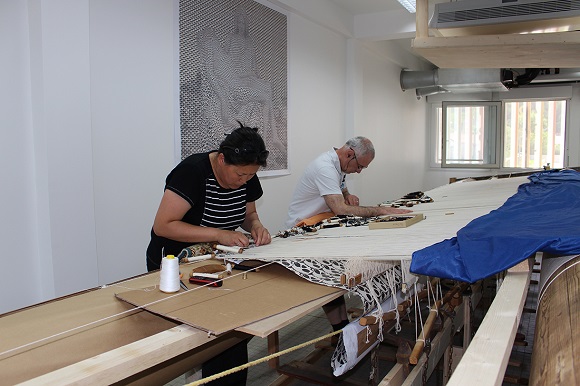
Tapestry for the centennial of WWI
Weavers can also been seen at work in the Cité Internationale de la Tapisserie Aubusson itself. The inaugural on-site project, currently underway, is a tapestry for the centennial of the First World War.

Woven by the workshop of Patrick Guillot, it is based on an image entitled Pieta for World War I by the German artist Thomas Bayrle. Measuring 4.5m x 4.5m (14.7ft x 14.7ft) and consisting of thousands of skulls, the pieta is being woven on a loom that has been specially installed for the project in the Cité. The tapestry will eventually be displayed at the Historial Franco-Allemand of Hartmannswillerkopf in Alsace, a French-German WWI museum to be inaugurated on Nov. 11, Armistice Day, 2017.
The Terrade spinning and dyeing company
Not all wool that that goes into Aubusson tapestries comes from sheep raised in Creuse. Furthermore, all manner of fiber and fabrics may be used in Aubusson tapestries: alpaca, camel, bamboo, synthetics, etc. Nevertheless, those in search of local tradition might drive down by the narrow Creuse River as it flows out of Felletin toward Aubusson, there to visit Filature Terrade, a spinning and dyeing business that has been run by the Terrade family for over a century. Filature Terrade has also recently received the national label Entreprise du Patrimoine Vivant (Living Heritage Company, or EPV).

Until 1950 the factory produced woolen cloth for shepherd’s capes before transforming into a spinning factory for wool and dying, primarily of sheep’s wool, using natural dyes. It is a small factory by industry standards, producing about 20 tons per year. It allows for a fascinating and personable introduction to spinning and dying. (Visits are organized by a local association; see information below.) Now operated by the third (Michel) and fourth (Thierry) generation of the founding Terrade family, the factory produces customized yarn for professionals. A small boutique on the site is open to the public and has excellent factory prices on wool yarn and knit products.
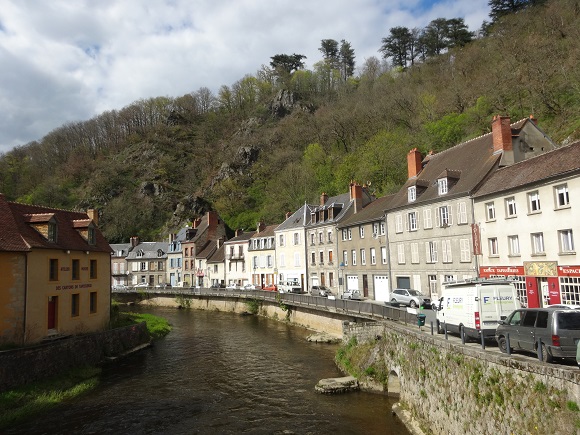
Practical Information and Contacts
See websites for opening times and entrance fee.
Cité Internationale de la Tapisserie Aubusson
Rue des Arts
23200 Aubusson
Tel. 05 55 66 66 66
Musée des Cartons de Tapisserie d’Aubusson
The images that weavers follow and interpret in creating tapestries are known as cartoons, cartons in France. This one-of-a-kind museum along the Creuse River as it flows through Aubusson present an exceptional collection of historic cartoon. It can only be visited on a guided tour, which is available in English.
Pont de la Terrade
1 rue de l’Abreuvoir
23200 Aubusson
Tel. 06 88 25 35 07
Filature Terrade (spinning and dying factory)
Rue de la Papeterie
23500 Felletin
Tel. 05 55 66 44 88
Don’t just stop by. Factory tours are organized by the association Felletin Patrimoine-Environement. The association (felletinpatrimoine@gmail.com) or the Felletin Tourist Office can provide further information about tapestry-related visits at Filature Terrade and elsewhere in and around the Felletin.
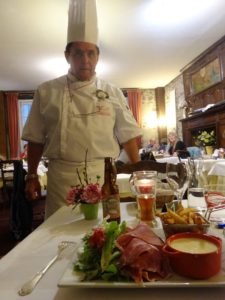
Hôtel de France
A charming and old-fashion 3-star hotel and restaurant in the center of Aubusson, amiably operated by René Jean Hawaï.
6 rue des Déportés
23200 Aubusson
Tel. 05 55 66 10 22
Aubusson Tourist Office
63 rue Vieille
23200 Aubusson
Tel. 05 55 66 32 12
Felletin Tourist Office
Place Quinault
23500 Felletin
Tel. 05 55 64 54 60
An annual exhibition of tapestries in the Gothic chapel at the center of town. In late October Felletin organizes National Wool Days (Journées Nationales de la Laine) http://journeesdelalaine.wixsite.com/felletin devoted to all aspects of the use and production of wool, from shearing to yarn to finished goods.
Information about Aubusson is available in Felletin and vice versa. Information about the overall Creuse region can be found at www.tourisme-creuse.com.
© 2016, Gary Lee Kraut
An earlier version of this article first appeared in The Connexion.

